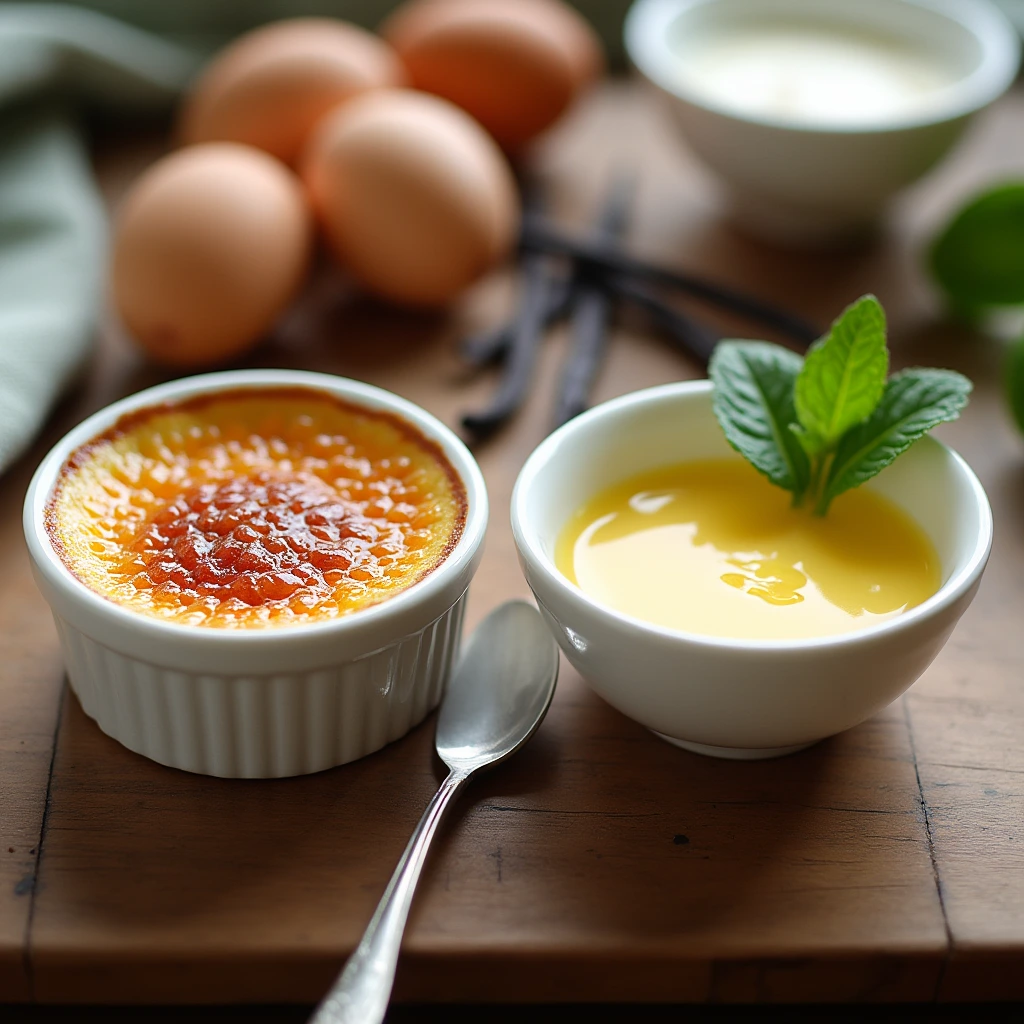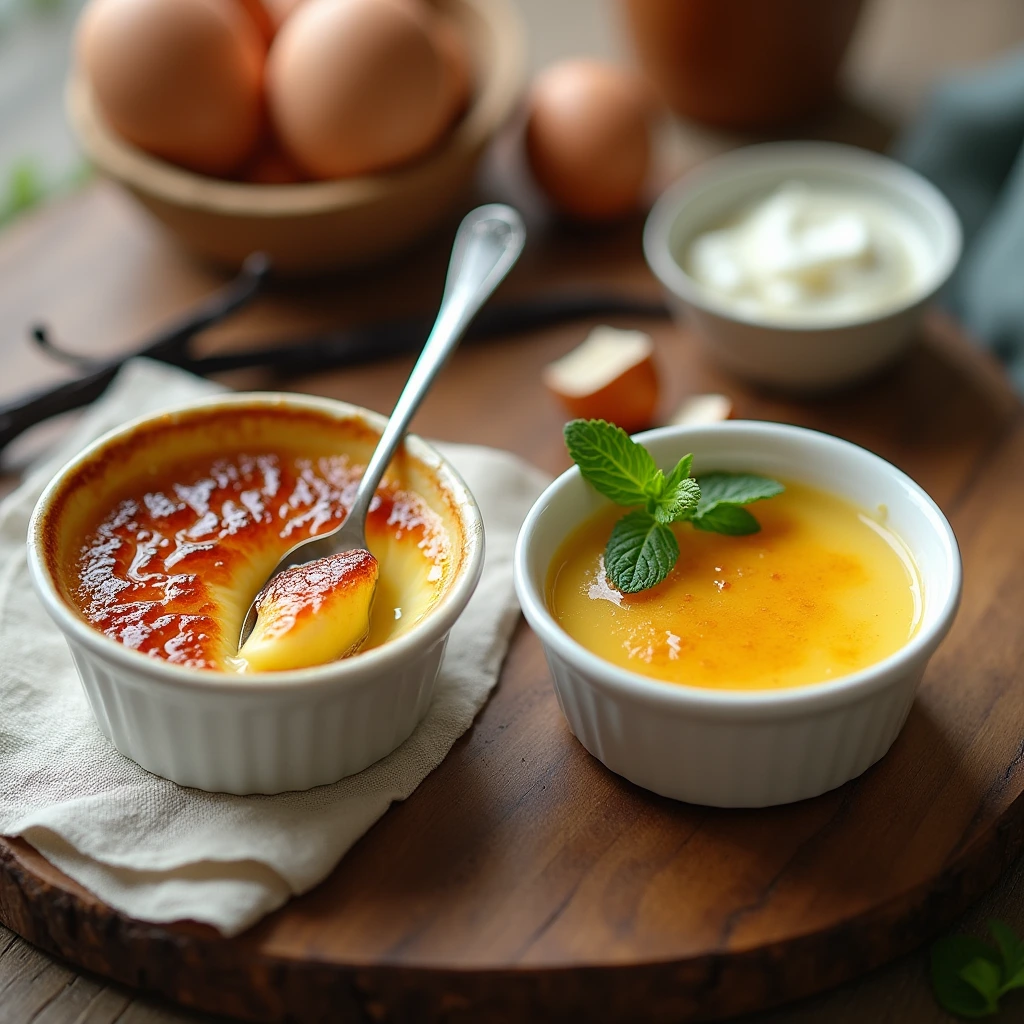Crème brûlée and custard are two popular desserts that look similar but have clear differences. Both offer a creamy and rich texture, using basic ingredients like eggs, sugar, and cream. Despite their shared traits, the preparation and enjoyment of each dessert set them apart.
Why do people often mix them up? Their similar ingredients and soft texture likely cause the confusion. However, understanding their differences allows you to choose the right one or confidently make them yourself.
Crème brûlée and custard hold more significance than just being delicious treats. These desserts play a role in culinary history, showcasing how chefs turn basic ingredients into something special. Let’s explore what makes each dessert unique.

What is Crème Brûlée?
Definition and Origins
Crème brûlée means “burnt cream” in French and is a dessert loved for its creamy custard base and crisp caramelized sugar topping. The name reflects its signature feature—a layer of sugar that chefs burn to create a crunchy texture.
The dessert’s history began in the late 17th century, with its origins debated among France, Spain, and England. While all three countries contributed to its popularity, France solidified its status as a classic dish in fine dining. Over time, crème brûlée became a staple on menus worldwide, admired for its elegant presentation and flavor.
Ingredients and Composition
Crème brûlée relies on simple ingredients that come together beautifully:
- Cream: Creates a rich and smooth base.
- Egg yolks: Give the custard its silky texture.
- Sugar: Sweetens the custard and forms the caramelized layer.
- Vanilla: Adds a classic aroma and flavor, often from vanilla beans or extract.
Many recipes offer variations, introducing flavors like chocolate, coffee, citrus, or spices. These twists make the dessert versatile and adaptable to different tastes.
Preparation and Cooking Method
Making crème brûlée involves a few key steps, all requiring care and precision.
- Bake the Custard in a Water Bath: Pour the custard mixture into ramekins, place them in a pan, and surround them with hot water. This technique ensures even cooking and prevents curdling.
- Caramelize the Sugar Topping: Once cooled, sprinkle sugar on top and melt it into a crisp, golden crust.
- Use the Right Tools: A blowtorch works best for caramelizing the sugar evenly. However, a broiler can serve as an alternative, though it may result in uneven browning.
Because of its mix of creamy custard and crunchy topping, crème brûlée remains a timeless dessert that appeals to many. Moreover, its simple ingredients and refined outcome make it a favorite in homes and restaurants alike.
What is Custard?
Definition and Types
Custard refers to a variety of dishes created by blending eggs with milk or cream. When gently heated, the eggs thicken the mixture, resulting in a smooth and creamy texture. This versatile preparation plays a key role in both sweet and savory dishes, making it an essential element in cooking and baking.
Typically, chefs classify custard into two main types:
- Baked Custards: These are cooked in the oven, often in a water bath, which helps create a firm texture. For example, flan and crème caramel fall into this category.
- Stirred Custards: These are cooked on the stovetop and remain pourable, as seen in custard sauces or pastry cream.
Moreover, custard features prominently in many desserts, such as crème anglaise and tart fillings. Its flexibility allows it to adapt to a wide range of culinary needs.
Ingredients and Composition
Custard relies on a few simple ingredients, yet it delivers a rich and indulgent experience. The main components are:
- Milk or Cream: This serves as the primary base, providing richness.
- Eggs: These thicken the liquid and give custard its signature texture.
- Sugar: This adds sweetness, although savory variations exclude it.
Furthermore, recipes for custard are highly adaptable. Cooks can adjust flavors to create sweet treats like éclairs or trifles, as well as savory dishes such as quiches or soufflés. This adaptability ensures custard remains a staple in both home kitchens and professional bakeries.
Cooking Techniques
The method used to cook custard greatly influences its final texture, so chefs carefully select their approach based on the desired outcome:
- Baking: Baking custard in a water bath promotes even heating, which creates a firm and sliceable texture.
- Stovetop Cooking: Stirring custard over low heat prevents curdling and results in a silky, pourable consistency.
- Steaming: Steaming, commonly used in some cuisines, produces a soft and delicate texture.
In addition to choosing the right technique, maintaining precise temperature control is crucial. Overheating can cause the eggs to scramble, while undercooking prevents the mixture from setting properly. Consequently, achieving the perfect custard requires attention to detail and patience.
Thanks to its versatility and wide range of uses, custard continues to hold a special place in culinary traditions. Whether served as a standalone dessert or incorporated into elaborate recipes, it delights with its creamy texture and satisfying flavor.
Key Differences Between Crème Brûlée and Custard
Texture and Consistency
Crème brûlée and custard differ greatly in texture, which makes each dessert stand out.
- Crème Brûlée: It offers a smooth, creamy base topped with a crisp caramelized sugar layer. The contrast between the soft custard and the crunchy topping enhances its appeal.
- Custard: Custard takes on different textures based on how chefs prepare it. Baked custards are firm, while stirred versions stay soft and pourable. This variety allows custard to suit many dishes.
Flavor and Richness
The flavor and richness of these desserts also set them apart. The cream-to-milk ratio and added ingredients play a key role in defining their taste.
- Crème Brûlée: Heavy cream gives it an exceptionally rich and smooth flavor. While vanilla is the most common addition, variations like chocolate and coffee offer creative options.
- Custard: Custards are more versatile. They work in both sweet and savory recipes. Adjusting the ratio of cream to milk changes its flavor—more cream adds richness, while more milk results in a lighter taste.
This flexibility makes custard a foundation for countless dishes, from desserts like trifles to savory treats such as quiches.
Presentation and Serving
The way these desserts are served highlights their differences even further.
- Crème Brûlée: Chefs typically present it in individual ramekins with a caramelized sugar topping that diners crack with a spoon. This adds a special touch to its elegant appeal.
- Custard: Custard appears in many forms. It can serve as a filling for pastries, a sauce for desserts, or a baked dish like flan. Its diverse presentations make it suitable for a wide range of dishes.
While crème brûlée impresses with its signature topping and refined look, custard stands out for its adaptability and variety. Both desserts continue to delight with their creamy textures and delicious flavors.
Similarities Between Crème Brûlée and Custard
Shared Ingredients
Crème brûlée and custard share a foundation of simple yet essential ingredients:
- Eggs: Both desserts rely on eggs as the primary thickening agent, which gives them their creamy texture.
- Dairy: Milk or cream forms the base for both, contributing to their rich and smooth consistency.
- Sugar: Adds sweetness and enhances flavor, making these desserts irresistible.
These shared ingredients highlight their common roots and explain why they are often compared. Despite their differences in preparation, these basic components remain consistent.
Culinary Techniques
Crème brûlée and custard also share similar cooking techniques that require precision and attention to detail:
- Temperature Control: Both rely on gentle heat to avoid overcooking. High temperatures can cause the eggs to scramble, ruining the dessert.
- Avoiding Curdling: Careful cooking ensures the eggs and dairy combine smoothly. Techniques like using a water bath for baking or stirring constantly on the stovetop help achieve a silky texture.
These shared methods reflect the delicate balance required to create desserts with perfectly creamy results. Mastering these techniques is essential for anyone looking to make either crème brûlée or custard.
Variations and Modern Takes
Innovative Crème Brûlée Flavors
While the classic vanilla crème brûlée remains a favorite, modern chefs have introduced creative flavor twists to elevate this dessert:
- Espresso: A rich and bold option that pairs well with the creamy custard base.
- Matcha: This green tea-infused version adds a subtle earthiness and vibrant color.
- Lavender: Floral notes bring a delicate, aromatic quality to the dish.
- Chocolate: A decadent variation that combines the richness of chocolate with the signature caramelized sugar topping.
These innovative flavors show how crème brûlée continues to evolve, appealing to diverse tastes while maintaining its elegant charm.
Diverse Custard Applications
Custard’s versatility allows it to shine in a variety of dishes, both sweet and savory:
- Desserts: Custard serves as a base for pies, tarts, and trifles. It’s a key component in treats like banana cream pie and custard-filled éclairs.
- Savory Dishes: Quiches and soufflés use custard as a filling, showcasing its adaptability beyond desserts.
- Global Varieties: Around the world, unique takes on custard highlight its cultural significance:
- Portuguese Custard Tarts (Pastéis de Nata): These flaky tarts are filled with a creamy egg custard and baked until golden.
- Thai Custards (Sangkhaya): These are often infused with coconut milk and served with sticky rice or steamed bread.
These diverse uses illustrate how custard transcends boundaries, offering endless possibilities for creativity in the kitchen. Whether in classic or innovative forms, both crème brûlée and custard continue to inspire chefs and delight diners worldwide.
FAQs About Crème Brûlée and Custard
Is Crème Brûlée a Type of Custard?
Yes, crème brûlée is a type of custard. Custard refers to any dish made by thickening a mixture of eggs and dairy through gentle heating. Crème brûlée falls under this category because it uses the same basic ingredients: eggs, cream, and sugar. However, its defining feature is the caramelized sugar topping, which sets it apart from other custards.
Why Does Crème Brûlée Have a Crunchy Top?
The crunchy top of crème brûlée comes from caramelization. After the custard has cooled, a thin layer of sugar is sprinkled over the surface. When the sugar is heated with a blowtorch or under a broiler, it melts and browns, forming a hardened, glass-like layer. This caramelized crust provides a satisfying contrast to the creamy custard beneath.
Can You Use Custard Recipes for Crème Brûlée?
While custard recipes share similarities with crème brûlée, not all custard recipes are ideal for making crème brûlée. Crème brûlée typically requires a richer custard base made with heavy cream and egg yolks to ensure a smooth texture. However, you can adapt some custard recipes by using cream instead of milk and adjusting the baking time. Don’t forget to add the signature caramelized sugar topping!
What Makes a Perfect Crème Brûlée?
A perfect crème brûlée has a smooth, velvety custard base and a crisp, evenly caramelized sugar top. Here are some key tips:
- Use Fresh Ingredients: High-quality cream, eggs, and vanilla enhance the flavor.
- Cook Gently: Use a water bath to prevent the custard from overcooking or curdling.
- Caramelize Evenly: Use a blowtorch for precise control over the sugar topping.
With careful attention to detail, you can achieve a restaurant-quality crème brûlée.
Are Custards Always Sweet?
No, custards can be savory as well. Savory custards often omit sugar and include ingredients like cheese, vegetables, or meats. Examples include quiches, soufflés, and savory pies. These dishes highlight custard’s versatility in both sweet and savory cuisines.
What’s the Difference Between Custard and Pudding?
Custard and pudding are similar but distinct desserts. Custard relies on eggs as a thickening agent, resulting in a smooth and creamy texture. Pudding, on the other hand, is usually thickened with cornstarch or flour, making it slightly less rich. Additionally, custard can be baked or stirred, while pudding is typically cooked on the stovetop. Both are delicious but offer different textures and flavors.
These FAQs help clarify common questions about crème brûlée and custard, showcasing their unique qualities and shared traits.
Differences and similarities
Crème brûlée and custard, while sharing a common foundation of eggs, cream, and sugar, offer unique experiences in texture, flavor, and presentation. Crème brûlée dazzles with its creamy base and crunchy caramelized sugar topping, while custard’s versatility allows it to fit into a variety of dishes, from baked desserts to savory creations.
Despite their differences, these desserts share key techniques, such as the importance of temperature control and achieving a smooth texture. Whether enjoyed as a standalone treat or as a component of a more elaborate dish, both crème brûlée and custard deserve a place in any dessert lover’s repertoire.
For those who love to cook, making these desserts at home can be a rewarding experience. Experimenting with variations of crème brûlée, like matcha or chocolate, or exploring global custard dishes, such as Portuguese custard tarts, can open up new culinary adventures.
Embrace the art of crafting these classic desserts, and savor their rich flavors and delightful textures in every bite!
More
For anyone looking to try new dishes, QuicklyTaste has plenty of easy and delicious recipes. If you want to learn about crème brûlée, their guide on How to Make Brûlée Topping shows you how to create the perfect crunchy sugar layer. If custards are your favorite, try the Lemon Tiramisu Recipe for a zesty twist on a creamy dessert. For more variety, check out savory options like Chicken Casserole with Ritz Crackers or the crowd-pleasing Filipino Macaroni Salad.
For even more ideas, visit external sites like Food52 and Serious Eats. These sites have simple guides and recipes for making custards and crème brûlée. They also share helpful tips for beginners and experienced cooks. With these resources, you can easily create tasty and impressive dishes at home.

